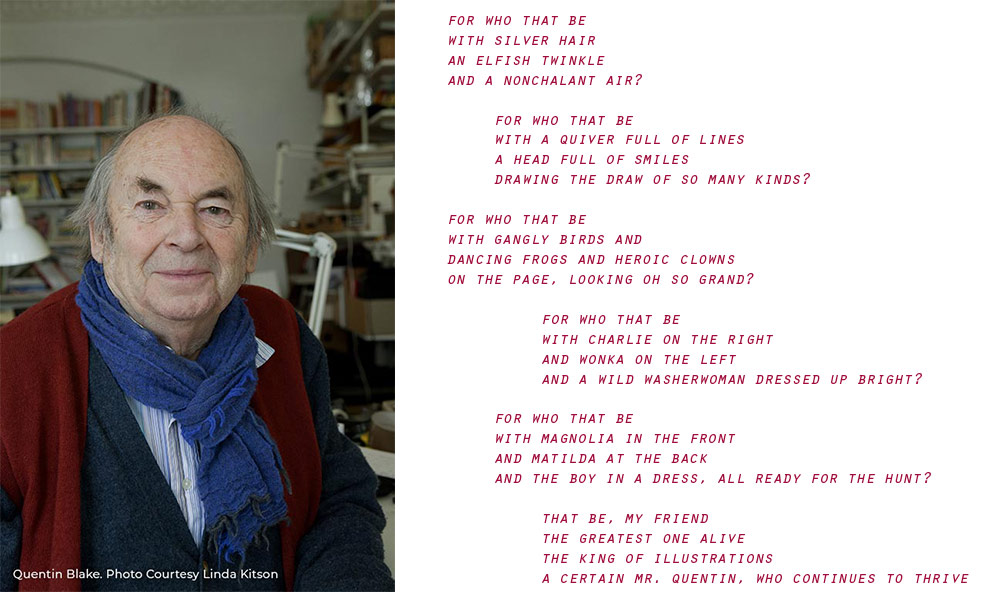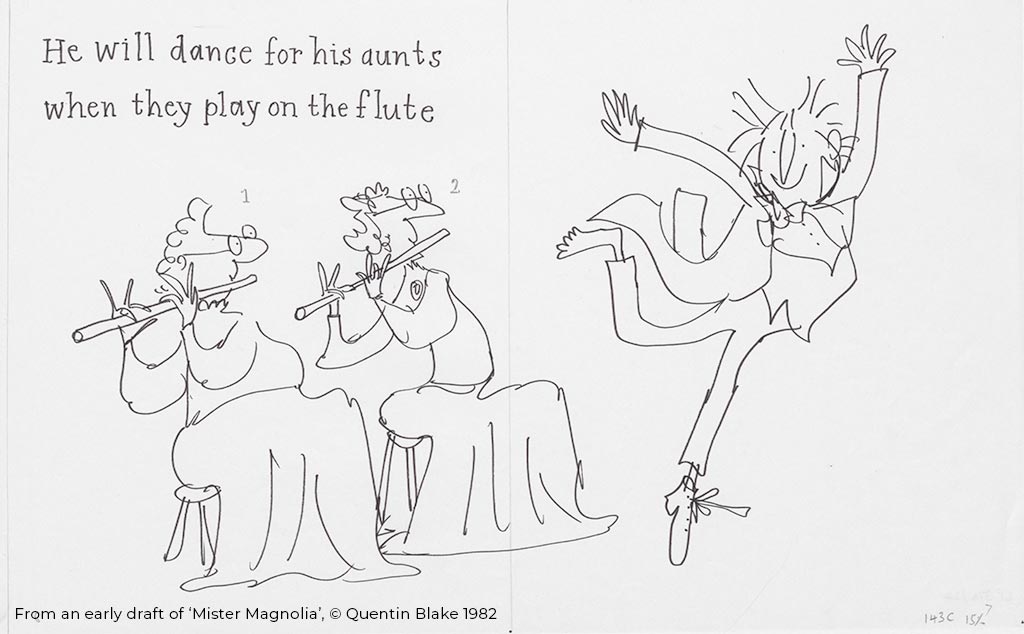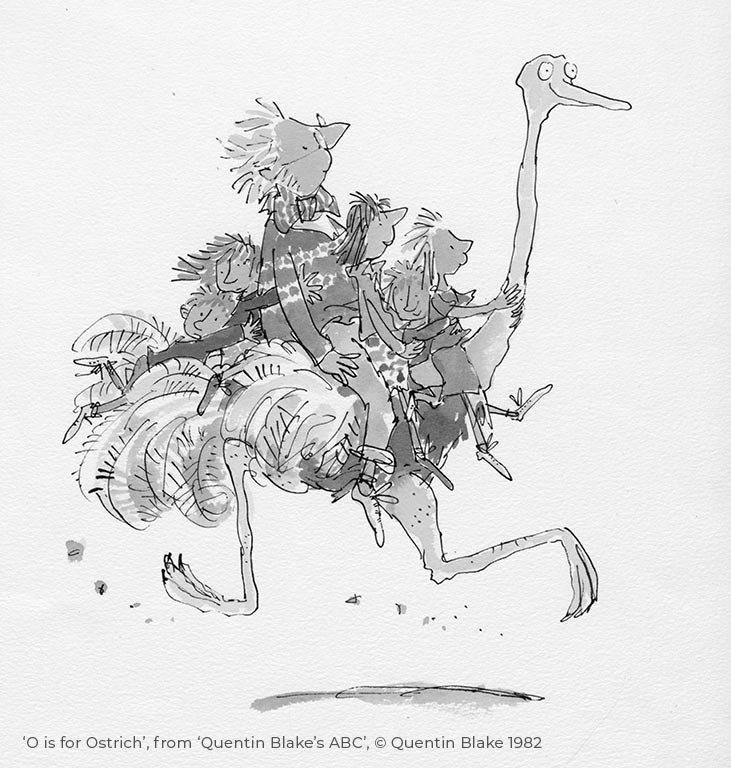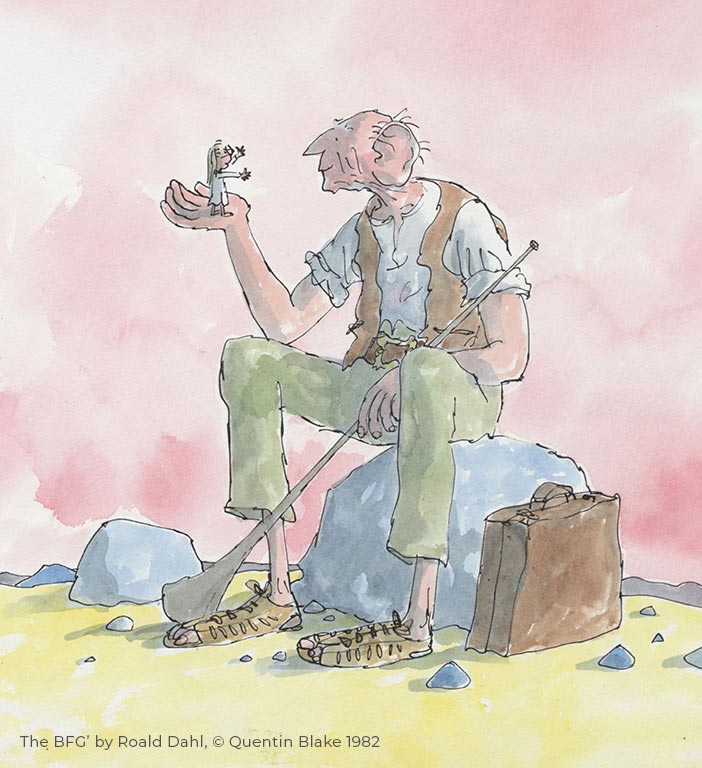The Line King
The elusive magic of Quentin Blake’s illustrations continues to cast its spell on readers, forever leaving behind traces of pixie dust in our imagination
Praveena Shivram

The images of childhood are often a phantasmagoric version of memory, with psychedelic colours swirling through the good and the bad, the ups and the downs, painting everything with the utterly uniform, and therefore improbable, brush of happy equanimity. This is a conscious state of being. We are aware of the glossing over, the smudges and the blurs contributing to that pleasant haziness of nostalgia as much as we are of certain experiences and moments shining through the fog like a beacon of light. We hold on to these encounters tenaciously, as they remain our tangible signposts while navigating this tricky space of pristine innocence through retrospective glasses. For me, and for many others who may have experienced this, one of those signposts is the fluid lines and high-energy illustrations of Sir Quentin Blake. They colour my memory like no other, the colours only becoming deeper and richer with the passing of time, the subtle nuances becoming brighter and the impact building such deep roots that it’s hard for me to imagine any other illustrator capturing my imagination with the steadfast consistency of Blake.
Born in Sidcup Kent in 1932, Blake says, in his website (quentinblake.com) that he ‘probably began drawing at the age of five’. ‘I remember a visitor during the war saying “He draws a lot, but he won’t speak!” I used to do drawings for the school magazine and also for Punch. I knew someone who drew for Punch and I started submitting drawings. I did get some little ones accepted when I was about sixteen or seventeen. That was a start. They paid me seven guineas each. I didn’t know what to do with the cheque; I didn’t have a bank account!’

Quentin’s illustrations have a rare charm and wit that somehow lends his drawings a fluidity of movement and an unmistakable character. There is flamboyance, there is subtlety, there is expression and there is range, sometimes within a story. My favourite is when Willy Wonka, characterised by his quirky smile and light step, suddenly becomes pensive by the waterfall in Charlie and the Great Glass Elevator, while Charlie’s grandparents fight over Wonka-Vite, the magic pill that makes you twenty years younger. Quentin’s illustration of this scene was a revelation. There is a stillness in Wonka that we haven’t seen till now and somehow, his posture with his hands clasped behind his back, his eyes looking up, his legs usually up in a dance now quietly supporting his burden of genius, and his suddenly static coat tail convey a depth of character, making Wonka that much more human. ‘What you really do when you start to draw is you imagine that you are that person and you go into the reactions you think you would be having. I find myself doing the faces as I’m drawing them,’ he says on his website. ‘I probably start with a nose, or a gesture – if someone is throwing something, for example. This is because facial expressions and gestures are the most difficult to get right; and I build the rest of the drawing around that. The studio is full of discarded pieces of paper with unfinished faces, or hands and arms, and nothing else!’ he adds.
From contributing to magazines such as Punch and The Spectator, Blake forayed into children’s books illustrations with friend John Yeoman’s A Drink of Water. ‘I suppose the first proper book I ever illustrated was while I was on National Service, before university. I spent three weeks illustrating a booklet – called English Parade – used in teaching those soldiers who hadn’t yet mastered reading…,’ writes Quentin on his official page. ‘From time to time I had to show my work to a lieutenant-colonel for his approval. A few moments of silence and then: “Very good, Sergeant Blake. But I think … the grass in this one ought to be shorter.” “Yes sir. I’ll see to it, sir.” “And I think the creases in these trousers might be sharper.” Of course, the problem with making the grass shorter in drawings is that you can’t cut it: you have to do the drawing again…’

This really points to the painstaking process of drawing illustrations that look so effortless on the page. Especially Quentin Blake’s illustrations that exude a raw spontaneity rarely found in children’s books. In the ‘How do I draw’ section of his website, Blake is quite candid about the process he employs to maintain the balance between the planning and the spontaneity. He calls it his ‘Light Box Technique’, where the rough drawing is placed on the light box, over which a fresh watercolour paper is placed for the actual drawing. ‘What happens next is not tracing; in fact it’s important that I can’t see the rough drawing underneath too clearly, because when I draw I try to draw as if for the first time; but I can do it with increased concentration, because the drawing underneath lets me know all the elements that have to appear and exactly where they have to be placed. Normally I begin with the most difficult piece of the drawing – some particular facial expression, some particular gesture or stance – so that if I get that wrong, I don’t have to repeat the whole of the drawing. Consequently, it’s not impossible for me to find myself at the end of a session of work surrounded by expensive sheets of watercolour paper with a small face bearing not quite the right expression in the middle of each,’ he writes. And with ‘scruffy-looking dip pens’ or a ‘brush, or a reed pen’ or ‘a quill’, and once even a ‘plastic toothpick’, Blake creates his special brand of magic.

Which brings me to his now-famous association with Roald Dahl that lasted 13 years, till the author’s death in 1977. In retrospect, it is hard to imagine one without the other. Would the BFG or Matilda be just as delightful without Blake’s imagination peppering the pages? Would the very same illustrations work without Dahl’s lively characters? It is, futile, of course, to even embark on this exercise of trying to separate the two, but the influence of their work is such that you cannot help indulging in the curiosity. And, at least for those outside of the United Kingdom, Blake continues to be recognised for his work with Dahl. A pity, really, as the sheer volume of Blake’s work outside of this association is vast and varied – from writing his own books (Mister Magnolia and Mrs Armitage are particular favourites) to successfully collaborating with several other writers to his illustrations for classics like A Christmas Carol and Candide to his work in public spaces, such as hospitals in the United Kingdom and France, to his role as the head of the Illustration Department at the Royal College of Art from 1978 to 1986 to his role as exhibition curator since the 1990s. And yet, it is Blake and Dahl who remain inseparable in public memory, both for their stories and the success it invited. This is what Blake says on his website about working with Roald Dahl: ‘To begin with, I was a bit nervous. He was quite a powerful figure. But we got on very well. He liked winding me up – only in the most harmless way. I often wore these white shoes, and he’d say “Here’s old Quent” – no-one else ever calls me that – “here’s old Quent, he’s going out for dinner in his plimsolls!’ ‘I think my favourite book of Roald Dahl’s to illustrate is ‘The BFG’, because I spent a long time talking to Roald Dahl about it and spent a long time thinking about the drawings; so by the time I finished, I knew the book very well.’’
In a career spanning over 60 years, Blake has received several prizes and awards, such as the 2002 Hans Christian Andersen Award for Illustration, the ‘Chevalier des Arts et des Lettres’ by the French Government in 2004, and being appointed the first ever Children’s Laureate in 1999, to help promote children’s literature for a period of two years. In 2013, he received the knighthood for ‘services to illustration’.
When asked in the ‘Hints and Tips’ of his official page what he likes drawing best, he says, ‘I like drawing anything that is doing something…’
Sir Blake, when you draw, anything is always doing something!
Share